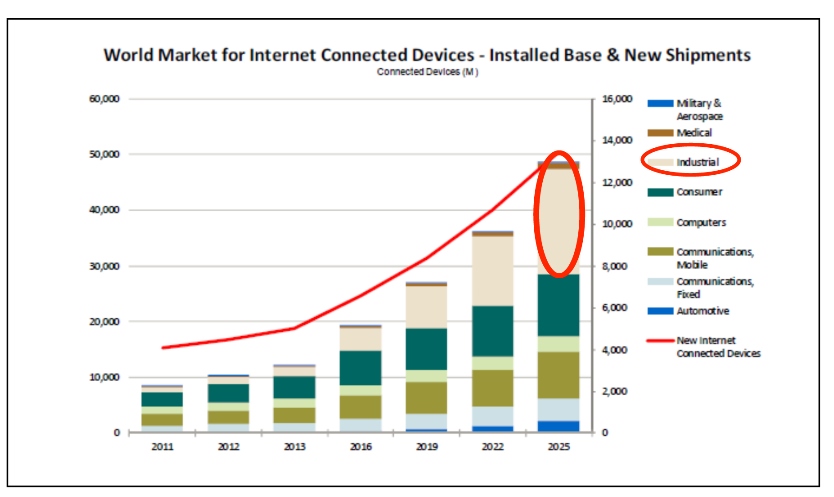Will Reduce Barriers and Open Doors for Building Automation Products in the Industrial Internet of Things

Bob Dolin,
CTO,
Echelon Corp.
|
March 2014 |
[an error occurred while processing this directive] |
|
Multiprotocol, Multimedia Solutions
Will Reduce Barriers and Open Doors for Building Automation Products in the Industrial Internet of Things
|
 Bob Dolin, CTO, Echelon Corp. |
| Articles |
| Interviews |
| Releases |
| New Products |
| Reviews |
| [an error occurred while processing this directive] |
| Editorial |
| Events |
| Sponsors |
| Site Search |
| Newsletters |
| [an error occurred while processing this directive] |
| Archives |
| Past Issues |
| Home |
| Editors |
| eDucation |
| [an error occurred while processing this directive] |
| Training |
| Links |
| Software |
| Subscribe |
| [an error occurred while processing this directive] |
Overview
The emerging Industrial Internet of Things (IIoT) represents the next
generation of control networks for building automation. But unlike the
consumer Internet of Things, the IIoT isn’t starting from scratch. The
hundreds of millions of building automation devices already operating
on networks, using a plethora of protocols and both wired and wireless
media, must be stitched together—easily and cost-effectively.
Echelon is focusing on multiprotocol, multimedia solutions that enable
interconnection and intercommunication among currently disparate
building automation networks. These IIoT-based solutions will not only
break down silos between various building automation systems, but the
use of a common IP infrastructure will also open new market
opportunities for device makers and help increase revenues through
streamlined inventory management.
The Need to Bring Devices and
Device Networks Together
Building automation systems today face similar challenges as those
faced by computer networking in the 1980s. Back then, competing
computer-networking systems—from companies such as IBM, DEC, Data
General, and Wang—had developed into a number of large islands. These
separate networks benefited each individual supplier and its customers,
but they made communicating across technologies difficult or impossible.
Looking inside a typical building today, you see air-conditioning
systems that can’t communicate with lighting systems, and security
systems talking yet another language on another network island. Besides
the potential efficiencies that could be gained if disparate building
automation networks could communicate with one another, there’s another
huge reason to overcome protocol and media incompatibilities among
these network islands: the Internet of Things and, more specifically,
the Industrial Internet of Things.
Market researchers such as those at IHS predict
that by 2020, the IoT
will represent almost 40% of all Internet-connected devices; that there
will be a billion industrial and commercial devices installed on the
IoT by 2017; and that the IIoT will add 500 million new units per year.
Those predictions provide tremendous economic incentives to enabling
communications among building automation devices on various networks.
Consumer IoT Solutions Won’t Work in the IIoT
While the IIoT is an important part of the larger IoT story, it’s a big
mistake to equate the consumer IoT—applications such as wearable
fitness trackers or home thermostats—with the Industrial IoT.
Industrial automation today is very sophisticated, and IIoT
requirements are far more stringent than those for the consumer IoT.
IIoT devices often operate in lights-out mission-critical environments,
where they need a certain toughness. For instance, IIoT devices require:
In addition, many IIoT situations do not require—and in fact are not
possible with—interaction with an Internet server or cloud. Unlike the
consumer IoT, the IIoT must include peer-to-peer, autonomous
communities of devices. For response-time reasons, nodes cannot wait to
be granted access to the network by a server, nor can they go through a
lengthy session set-up sequence.
Traditionally, these communities of devices adopted protocols meant to
work specifically for their prescribed operations. In building
automation, the result has been the rise of protocols such as BACnet,
LonTalk, DALI, C-Bus, Modbus, X10, etc.
The Role of IP
The flourishing of the Internet depended on bridging the disparate
networks connecting PCs of the 1980s era. That bridge was IP: Internet
Protocol.
For the IoT and IIoT, IP can also serve as the bridging protocol. More
specifically, it will be IPv6, which will expand the addressing
capabilities of IP to encompass the billions of devices expected to
make up the IoT.
Currently, industrial systems connect to the Internet and internal IP
networks through gateways. These gateways require custom provisioning
and programming to expose the necessary data to the enterprise systems.
Invariably, the gateway constrains what information can pass back and
forth, and its configuration is difficult to evolve to support new
requirements. For control networks in building automation, IP
addressing will move from the gateway to the field bus level, and
gateway functionality—e.g., the translation of data into a common
format—will be integrated onto chips. At the same time, there will be
greater reliance on routers than gateways for connecting networks.
Still, transitioning the billion or so legacy industrial devices will
take more than IPv6. Because IP stops at the addressing and routing of
packets, there will be a need for higher-level protocol services
running on top of IPv4/IPv6 UDP socket interfaces that manage
reliability, security, and device interoperability. That’s where the
multiprotocol IzoT platform for the IIoT comes in.
The Multiprotocol IzoT™ Platform
for the IIoT
The Echelon IzoT platform—available initially as software stacks and
system-on-chip (SoC) offerings—is designed to provide a pathway to the
IIoT for both the installed base of legacy industrial devices and new
devices.
Some of the characteristics and capabilities of the IzoT platform
important for building automation networks include:
The IzoT platform includes technology that simplifies the incorporation
of both existing and new building automation devices and networks into
the IIoT. For example, the decision to base the IzoT stack on UDP
rather than TCP permits the use of multicast and confirmed multicast
messaging so that a single message can simultaneously go to multiple
destinations. As a result, more-constrained nodes can work on slower,
more error-prone links—which allows systems designers to economically
extend IP to the simplest of control nodes.
Above all, however, the IzoT platform is noteworthy for its ability to
provide a full range of industrial-grade capabilities while also
supporting multiple protocols, over a common IP infrastructure, within
a single device or application.

Implications of a Common IP
Infrastructure for the Building Automation Market
[an error occurred while processing this directive]
The ability of both existing and new building automation devices,
running whatever protocols have evolved within their particular
domains, to interoperate with one another is key to extracting optimal
benefit from the IIoT.
Interoperability among currently disparate building automation networks
will not only increase their efficiency, manageability, and
cooperation, it will also improve the overall quality and safety of
building automation systems.
Multiprotocol support has huge implications for the business of
building automation companies. Instead of designing, manufacturing,
supporting, and tracking different unique products for each protocol
option, companies can reduce their number of SKUs (stock keeping units)
when a single device can be configured to support multiple protocols.
Companies can also expand their business. For instance, those that
traditionally have made only LonWorks products can now also compete for
BACnet bids, and vice versa.
At a higher level, then, multiprotocol, multimedia device and
application support over a common IP infrastructure will allow building
automation companies to address new markets and to reap greater
revenues for the same design effort.
About the Author
Robert "Bob" Dolin, Echelon’s system architect, has worked for the
company since 1989. He is the principal or co-inventor of 14 Echelon
patents, and is a designer of the LonWorks protocol, the network
development system environment, the Neuron C programming model, and
LonWorks network management. Before joining Echelon, Dolin spent 11
years at ROLM Corporation, where he was a main developer of its PBX
telephone system Dolin has a B.S. degree in Electrical
Engineering and Computer Science from the University of California at
Berkeley.
[an error occurred while processing this directive]
[Click Banner To Learn More]
[Home Page] [The Automator] [About] [Subscribe ] [Contact Us]